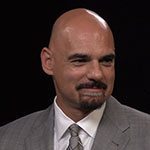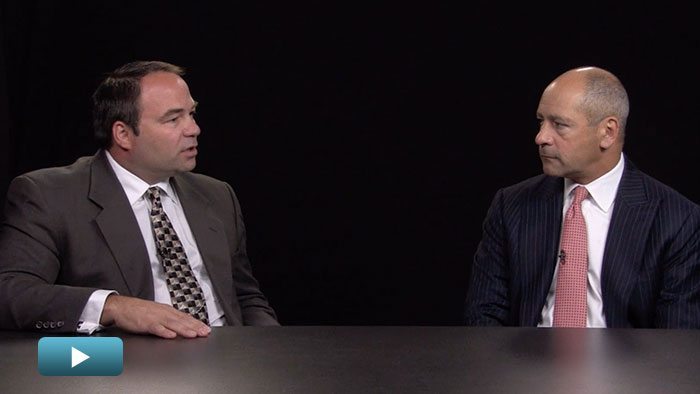Senior Living: It’s All About The Operators
Picking the right operator is one of the most important decisions investors will make investing in the U.S. senior living market, according to Noah Levy of Prudential Real Estate Investors and Chris Kazantis of AEW Capital.
Transcript Download Transcript
Senior Living: It’s all about the Operators
Inside Senior Living Investing
Zoe Hughes, PrivcapRE: I’m joined here today by Noah Levy, Managing Director at Prudential Real Estate Investors, and Chris Kazantis, Director at AEW Capital. Thank you both for joining me today.
Noah Levy, Prudential Real Estate Investors: Great to be here.
Chris Kazantis, AEW Capital Management: Thank you.
Hughes: There is no doubt that the senior housing sector is an exceptionally operationally-intensive business…[it] incorporates obviously a bit of residential, a bit of hospitality and a bit of healthcare and it was described to me very recently as a nickel-and-dime-type business. But [it’s] one that is truly about the people. I know you both have very strong views on the operational side of the business. Is a successful deal all down to the operator you choose?
Kazantis: Yeah, this is an operational-intensive business and also, I think it’s a business about caring for people. I don’t think you can just parachute into this industry and say, “I think the demographics are great, the returns are phenomenal, I can get a lot of rent growth and I am going to make as much money as I possibly can and get in and get out.” There are people who try and do that but they are usually not successful over a period of time. Most people who are in this industry are in it because they have a passion for this industry. They care about seniors—they care about taking care of seniors and care about their family members.
You need to have a culture in place and you need to hire the right people, caring people, to have that kind of culture in a community and an organization. And I think the operators and the organizations that have that are the most successful.
Levy: One of the old salves in real estate is “location, location, location.” In our business, it’s really “operator, operator, location.” And, parroting what Chris is saying, you’re only as good as your least happy employee. You need, from top to bottom, to have a real passion and focus on the residents. These are the toughest customers you’ll ever love.
Not only a building full of folks who are 84 or 85, with all their various issues and the fact that they are tough customers, but you are talking about all their families and friends. Really, you’re not just engaging in day-to-day services and care. And we’re talking about support services, not health care, but you’re also engaging families and a community. That’s a really tough thing.
It’s not like a hotel would be, where people come in for one night and if they are not thrilled with the meal or the way the room laid out, [it’s] not a big deal. We always say you can have a perfect building, but if you don’t have the right people running it, it could be a lousy investment, as opposed to you can have a less-than–bright, shiny penny but if you have great people it could be a fabulous investment.
Kazantis: And you could see that. You go into marketplaces and you can see buildings that are latest and greatest, [with] all the amenities, and they are 70% leased. And you see another building that might be a bit older and might not have all the same amenities, but that building is 100% leased.
Hughes: Do you find in your experience—obviously you know, having done this for so long—that it’s better to be with a smaller operator or perhaps a smaller regional, local operator or a larger one? What are your experiences telling you?
Levy: I think we have the proponents our investments have been with some of the smaller, regional operators, but we’ve had very good experiences with some of the larger operators as well. It’s just a matter of who needs capital, on what scale and what scope. Frankly, some of the folks have gotten so large, they reach escape velocity, and they perhaps don’t need our equity. That’s really the more determinate thing.
We want that intersection of a great operator with a great asset in the right market. And you want to be where those three circles—to use a Venn diagram kind of analogy—you want those three circles to overlap. Sometimes, we’ve had really good deals with larger operators. But they need to be able to pay attention to your investment and you can get lost in a larger organization. That’s not that they want to, it’s just the nature of things.
Kazantis: And it goes both ways. There’s some issues on the smaller side; it’s great because they have focus and they can really drive that culture that I alluded to at the property, but they might not have as much as back office, as much training or as much scale. Then, on the larger side, you’re going to have access to a lot more resources, if you will. But it’s going to be harder for them to consistently have that kind of culture down to every single property. So I think you can get too big in this industry. You can get to a point where you just lose it a little bit.
Hughes: Talk to me about the operations. What kind of facilities you need to produce? The real estate: does it…need to have more activities, more community, more healthcare, more Wii or computer games? How is it actually impacting your strategies, this changing demographics?
Levy: These buildings have had those things. Obviously, [in] newer buildings, you can build say state–of–the–art therapy rooms or exercise areas or bigger auditoriums and the like. But older projects, if well–maintained, can still do the same things.
We are seeing more in the way of programming. I think it’s important to be able to offer not just activities, but things that really engage the resident in the community. It’s important to have exercise facilities and availability for therapy in the building. Things like that. Even doctors’ offices, or visiting doctors’ offices, so the people and residents can have more services brought in to them, whether the operator [itself] is actually the provider of the service or not.
Kazantis: Some of the biggest changes I have seen [are] on memory care. Memory care was always an afterthought before, which was horrible. People used to ask, “What are the least desirable units we have, the ones with no views, overlooking the parking lot? We are going to turn those into memory care.” There wasn’t very much programming, natural light or any of that. They were basically warehousing people. It was really a horrible environment. Now, that’s evolved to a point where memory care is now so state-of-the-art and where they are trying to get people and help them in very early stages to try and prevent the progression of the disease.
Hughes: Does this mean that you obviously, as investors, as allocators, need to underwrite more CAPEX into your properties?
Levy: That’s been one of the things. And I think some of the observers have been good on this point, which is for many years, we were living with…a loan underwriting CAPEX per unit that was very low. And it is expensive to maintain these projects, in part because they are smaller. They are highly amenitized. So, you’re spreading that FF and E dollars over relatively few units. The numbers per unit could be quite large and you’ve got to be prepared to spend it.
That’s just the flat-out reality of it. Or, you could go the other way. If you will get what you pay for. If you don’t want to spend it, you better hurry up and get out because it will be a problem. Pay now or pay later.
Kazantis: A lot of it is [asking] “What’s your capital source? What’s the money behind your capital source” I think Noah and I have a very similar philosophy and we put money into our projects, we maintain our projects and we keep our projects as state-of-the-art as we possibly can. And that’s one of the reasons we have the operators we get because they like partners that will do that. But there [are] opportunity funds out there that are looking for much higher returns that will capital-starve a lot of their properties.
Hughes: Can you actually control your expenses a little bit or this is an industry you have to invest your money into?
Levy: You have to control your expenses as much as you can. Obviously, labor is a large input. Food costs and energy costs…are a large input. You have to do the best you can all around. One thing that some of the earlier pioneers really figured out, to give you an example, [was] food costs. Every time you throw food into the garbage can, those are nickels and dimes that are going into the garbage can. And since you’re so highly levered, the incremental revenue or whatever you save on expenses—almost all of it goes to the bottom line.
…For instance, doing a cafeteria line. This is what this one operator figured out….Because it’s a pain if you’re older to go through a cafeteria line, you take too much food because you don’t want to go back. You know what? I am going to hire folks to serve you and say, “You can have any amount you want. What size portion do you want? If you want more, you want seconds, we’ll give you seconds.” And their food costs went down like this because they weren’t throwing it away. That was all found money.
I think those are the kinds of operational things you need to be entertaining—buying contracts for forward contracts for energy costs or things like that where you need to be careful. But you cannot skimp on taking care of your employees. This isn’t a minimum-wage business. People are getting healthcare. You have to take care of the caregivers. If you don’t, you are going to have problems….People won’t stay. You won’t be able to retain them and you will not have the kind of service you need.
So, you need to be careful with your expenses but that doesn’t mean you are cheaping out on your employees or your residents. You can’t do it that way either. That’s why I say it is a nickels–and–dimes business, but you have to have a passion for it.
Kazantis: Right. And…[that] gets back to your earlier point about smaller operators and larger operators. They both have pros and cons. But if you can react very quickly at the property level, you can maintain your margins and maintain your NOI even if you have a short-term blip in your census because you can manage hours of staff, you can manage ordering your food. So if your census drops by 5% or 10%, you can keep the same NOI for a few months until you build the census back up.
If you have a smaller or more regional, they are all over that. Some of the larger operators unfortunately can’t react as quickly as that, so you see a bit more volatility to their cash flows when there is a drop in census.
The one thing I don’t think you’ve hit on—and I am sure Noah would agree with—is that there is no right one-size operator. I mean, every operator’s model can be slightly different. Every operator figures out their model and you can’t just say, “That’s the right model. I am going to drop that on every single property.”
Levy: No two buildings look alike, even the same operator will tell you this market is a bit different from that market—we have to change the menu. There are a variety of things that even the same operator will tell you, “We have to manage this a bit different.” There’s no one–size–fits–all and, in some ways, it’s all about customer choice. This business has been about customer choice and that means operators need to develop their own style.
Kazantis: You look at the future and you mention the baby boomers right now. When we first got into this, it was the greatest generation. That was a pretty homogenous generation. They all went off to school together, they all went off to war together, they all came back, they all lived in very similar houses.
When we get into the baby boomers—talk about segmentation and not one–size–fits–all. You’re going to have to have so many different types of properties and operators.
Hughes: In what way?
Kazantis: When the baby boomers get here, you’re going to have to have so many different types of segments of the industry. It’s going to be very similar to what the hotel industry is now. You are going to have really high-end stuff like the Four Seasons and you are going to have to have a much more affordable model for people who didn’t save as long.
We haven’t gotten into affordability, but that’s obviously a big issue in this segment in this industry and it’s going to continue to grow as more and more baby boomers start coming in.
Hughes: Let’s pick up on affordability, because both of you have previously told me it’s like the holy grail of senior housing. Is there an affordability issue when it comes to senior housing?
Kazantis: I think there is an affordability issue. It’s kind of a double-edged sword. First of all, many more people can afford the product than they probably think they can at first because there are multiple pockets of money that you have. You have Social Security, you have retirement benefits, you have any of your investment income that you’ve saved over the years. You have your primary house, you have a secondary house, you have cars.
And when you’re moving from your primary house, you add up exactly what you’re spending on your primary house as far as how much you pay for your car, how much you get paid to maintain your car, how much you pay for your insurance and your cable how much you buy for food every single day. You start adding up all those daily expenses that people are spending but they don’t realize they are spending and that’s all-inclusive when they go to senior housing. They figure out, “Wow, this is more affordable than I think it is.” That’s kind of where we are today but, even with that said, prices have gotten to the point where it can get extremely expensive. Our average AL rents could be $4,000 to $5,000 a month. You get into memory care and it could be $5,000 to $7,000 a month. So, having a more affordable product is definitely something everyone is trying to work on.
And we’re saying, “Why don’t we build projects [where] the entire projects are shared units?” It’s like the old days—going to schools or dorms, you have a private bedroom. You can shut your door. There is some privacy, but you’re sharing a common area.
You want the common areas to be every bit as nice as full market–rate stuff but, by having those shared units, you’re able to bring your costs down 20% to 40% per resident. You have to try and think creatively like that. I think there are a lot of operators out there that are trying to come up with a model to appease or to go to a much bigger market segmentation because, historically, it’s easier to just build to the wealthy.
Levy: I think it is true that very little has been built for the low–to–middle–income senior. It’s been mostly upper–middle to upper–income seniors. Obviously, trying to find lower price points within buildings even in the face of that, where you have smaller units or shared units, people have done a variety of things like that. Getting back to the affordability issue, when you start going through numbers and you think about how long people are likely to be and what savings it would take, it is remarkably affordable.
In fact, given how large this baby boom wave is going to be, the concerns about affordability really aren’t going to be there. It’s the law of large numbers. They are going to have a very large age cohort. Yes, maybe a certain percentage will not be able to afford it, but a vast majority will.
There’s another element of this, which is the length of stay. If you start trying to replicate the services that you get in our buildings, in the buildings that these operators run, if you actually sat back and said, “Wait a minute, you’re going to have people around 24 hours, you are going to have somebody to cook these meals and, by the way, if there’s a storm, or if there’s a power outage, or if someone needs a vacation, we got that covered”—if you tried to replicate that in your home, you couldn’t even come close. By the way, the quality you have is also a heck of a lot better and, because families are mobile and they don’t necessarily all live close by and the like, it’s almost impossible for families to replicate that.



